

>>>>>Considered one of the best plants for solving your most difficult dry-shade landscape challenges.
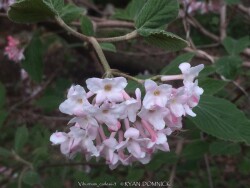

***Shrub descriptions available with future update!***
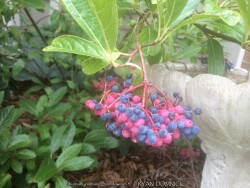

***Shrub descriptions available with future update!***


>>>>>Decker Prague Evergreen Viburnum (Viburnum pragense 'Decker') is a hybrid between leatherleaf viburnum and €â€â‚¬â€â‚¬â€â‚¬â€â‚¬â€-The key difference is that Prague viburnum is slightly faster growing and more consistent reliable evergreen foliage. Foliage is more of a green color during the winter and very glossy. Craig viburnum has more narrow denser foliage. It can be easily pruned into a green wall or large hedge for screening.
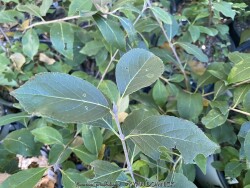

Blackhaw Native Viburnum, is also known as Viburnum prunifolium
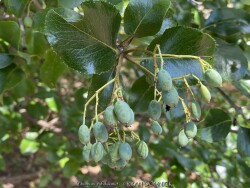

Rusty Blackhaw Native Viburnum, is also known as Viburnum rufidulum
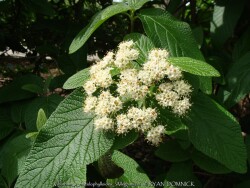

Leatherleaf viburnum is a large semi-evergreen shrub with leathery leaves and cream white flowers. Foliage emerges light green with powdery white material on the backside of the leaf. Foliage darkens to a medium green by summer and finally turning to a purplish winter color. About half of the foliage drops in the winter but is still effective enough for a partial screening. Flowers bloom mostly in spring but sporadically throughout the year. If pollination occurs, red fruits follow in the late summer thru fall creating quite a show. More than one variety is typically required for pollination. Leatherleaf viburnum prefers medium to rich garden soil in full to part sun. Being one of the toughest viburnums around, it can handle much less than ideal conditions including dry shade. Typically our are 40 inches of rainfall per year in eastern Kansas is enough without extra water. However, during times of drought, the foliage will wilt and growth will stop. Luckily the foliage is able to survive in a wilted state for a long time (usually up to two or three weeks) before actually dying. This gives you plenty of notice that it needs water. There is virtually no maintenance except rejuvenation on very old plants. Yearly fertilizer application is appreciated. When given plenty of room to grow, Leatherleaf Viburnum can reach up to 8 or 12 feet tall and wide after 20-30 years. Eventually old canes become unproductive and should be removed allowing young vigorous canes to develop. Leatherleaf viburnum grows slow at first especially in rough soils but the key thing is that it will survive and grow faster when established. Cold hardiness is not a problem in Lawrence Kansas zone 6a but in colder climates expect winterkill down to the ground in some years. Considered one of the best plants for solving your most difficult dry-shade landscape challenges. Several improved cultivars exist. Alleghany Leatherleaf Viburnum (Viburnum x rhytidophylloides 'Alleghany') has improved cold hardiness and growth form.


Leatherleaf viburnum is a large semi-evergreen shrub with leathery leaves and cream white flowers. Foliage emerges light green with powdery white material on the backside of the leaf. Foliage darkens to a medium green by summer and finally turning to a purplish winter color. About half of the foliage drops in the winter but is still effective enough for a partial screening. Flowers bloom mostly in spring but sporadically throughout the year. If pollination occurs, red fruits follow in the late summer thru fall creating quite a show. More than one variety is typically required for pollination. Leatherleaf viburnum prefers medium to rich garden soil in full to part sun. Being one of the toughest viburnums around, it can handle much less than ideal conditions including dry shade. Typically our are 40 inches of rainfall per year in eastern Kansas is enough without extra water. However, during times of drought, the foliage will wilt and growth will stop. Luckily the foliage is able to survive in a wilted state for a long time (usually up to two or three weeks) before actually dying. This gives you plenty of notice that it needs water. There is virtually no maintenance except rejuvenation on very old plants. Yearly fertilizer application is appreciated. When given plenty of room to grow, Leatherleaf Viburnum can reach up to 8 or 12 feet tall and wide after 20-30 years. Eventually old canes become unproductive and should be removed allowing young vigorous canes to develop. Leatherleaf viburnum grows slow at first especially in rough soils but the key thing is that it will survive and grow faster when established. Cold hardiness is not a problem in Lawrence Kansas zone 6a but in colder climates expect winterkill down to the ground in some years. Considered one of the best plants for solving your most difficult dry-shade landscape challenges. Several improved cultivars exist. Darts Duke Leatherleaf Viburnum (Viburnum x rhytidophylloides 'Dart's Duke') features larger dark green foliage, larger flowers, better density, and pink cottony flock on the back of new leaves and new stems instead of white. All Proven Winners® plants are legally propagated, healthy and vigorous, true to name, and tagged with color pictures and growing information.
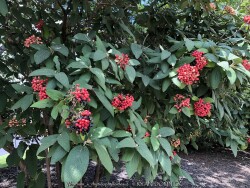

Leatherleaf viburnum is a large semi-evergreen shrub with leathery leaves and cream white flowers. Foliage emerges light green with powdery white material on the backside of the leaf. Foliage darkens to a medium green by summer and finally turning to a purplish winter color. About half of the foliage drops in the winter but is still effective enough for a partial screening. Flowers bloom mostly in spring but sporadically throughout the year. If pollination occurs, red fruits follow in the late summer thru fall creating quite a show. More than one variety is typically required for pollination. Leatherleaf viburnum prefers medium to rich garden soil in full to part sun. Being one of the toughest viburnums around, it can handle much less than ideal conditions including dry shade. Typically our are 40 inches of rainfall per year in eastern Kansas is enough without extra water. However, during times of drought, the foliage will wilt and growth will stop. Luckily the foliage is able to survive in a wilted state for a long time (usually up to two or three weeks) before actually dying. This gives you plenty of notice that it needs water. There is virtually no maintenance except rejuvenation on very old plants. Yearly fertilizer application is appreciated. When given plenty of room to grow, Leatherleaf Viburnum can reach up to 8 or 12 feet tall and wide after 20-30 years. Eventually old canes become unproductive and should be removed allowing young vigorous canes to develop. Leatherleaf viburnum grows slow at first especially in rough soils but the key thing is that it will survive and grow faster when established. Cold hardiness is not a problem in Lawrence Kansas zone 6a but in colder climates expect winterkill down to the ground in some years. Considered one of the best plants for solving your most difficult dry-shade landscape challenges. Several improved cultivars exist. Red Balloon Leatherleaf Viburnum (Viburnum x rhytidophylloides 'Red Balloon') features significant improvements. In spring, large, lacy white flower clusters cover the plant, followed by green fruit which turns brilliant red in late summer. The thick, leathery foliage lends a distinguished, handsome look to the plant all season. This viburnum will develop some berries without another variety as a pollinator, but you'll get more fruit if planted around 'Mohican' or 'Alleghany.' Proven Winners® plants are legally propagated, healthy and vigorous, true to name, and tagged with color pictures and growing information.
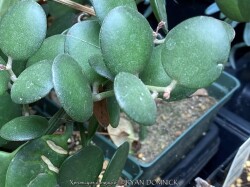

Silver Dollar Plant (Xerosicyos danguyi) are unique because they have perfectly round leaves and vining stems. These tropical vines have a few requirements in order to thrive but nothing too hard. Give them bright indirect light and water only when dry. They are usually grown as a house plant in Kansas but can be moved outside if kept in full to part shade. Leaves can sunburn but morning or filtered sun is ok! Xerosicyos danguyi is native to West and South-West Madagascar. In the wild, this species subarid bushland forest and dunes that occasionally frost. Potted plants are hardy to at least 25 degrees F for a short time if kept dry so you are ok if you miss the first light frost. Do not allow the pot with rootball to freeze solid though. Move into a cold garage, basement, or bright window over the winter with occasional watering. As a winter house plant, it will look presentable all winter long with just a few waterings. Repotting may or may not be needed depending on how large you want the plant to grow; plants can continue to grow in the same pot for years. If repotting, make sure to use a sharp draining medium organic cactus mix with plenty of sand and perlite. To play is safe, outside potted plants are best moved in before night temperatures get below 35 degrees F. It is important to avoid the combination of wet and cold. Potted plants are very low maintenance; I have never seen a pest on this plant. This is relatively rare plant never seen at the big box stores and will command a higher price than most other houseplants.
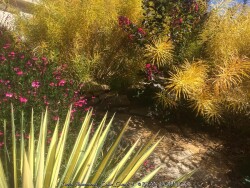

Adam's needle yucca (Yucca filamentosa) is a slow-growing broadleaf evergreen perennial. Blue-green leaves form rosettes about 2-3 feet tall and wide. Tall white flower spikes reliably appear on mature plants in May and June. If pollination is successful, attractive seed heads form later turning to black before cracking open. Although yuccas are more typical of western deserts and grasslands, this one is native to central and eastern United States. Tough as nails, yuccas are the ideal plant for a no-maintenance garden. Normally a plant has specific requirements for success but Adam's needle yucca has only one: it cannot tolerate growing in standing water or really wet soil. Plant in full sun to dry shade in any soil! In the landscape yuccas are often seen planted alone by a mailbox or neglected old landscape because they have outlived the original owners and the landscape service life. The root system of decades old plants may take up the underground volume of a large trash can. Yuccas look best when combined with other flowering plants providing texture and color. In mass plantings, yucca can create an interesting architectural look. Combined with ornamental grasses, yuccas can create stunning contrasts with winter grass colors of pink, orange and rust. Yucca flowers are pollinated exclusively by the yucca moth and deserve a place in native plant and pollinator gardens. This is a true 4-season "Once it's there, it's there forever" plant! Color Guard Yucca (Yucca filamentosa 'Color Guard') is a beautiful variegated variety with a bright yellow stripe down the middle of the leaf. The yellow color turns pinkish red with full winter sun and cold temperatures creating a stunning effect. Landscape designers often count on this variety for winter color!
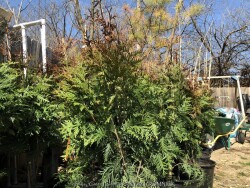

***Tree descriptions available with future update!***
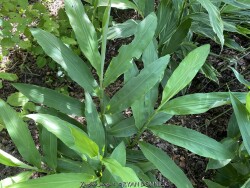

>>>>>In our trial gardens in Lawrence, KS (zone 6a), three established mulched specimens survived -17 degrees F. During the arctic blast of February, 2021, lows down to -17 degrees F on Feb 16th, 2021 were recorded. The longevity of this cold blast was also impressive: 10 days on a row with highs of 10-15 degrees F or lower, 8 nights of lows in the single digits and negatives, and 36 strait hours of 0 degrees F and mostly lower.
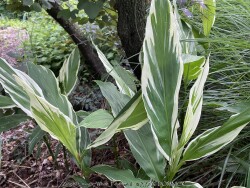

White Feather Hardy Edible Ginger / Zingiber, is also known as Zingiber mioga 'White Feather'